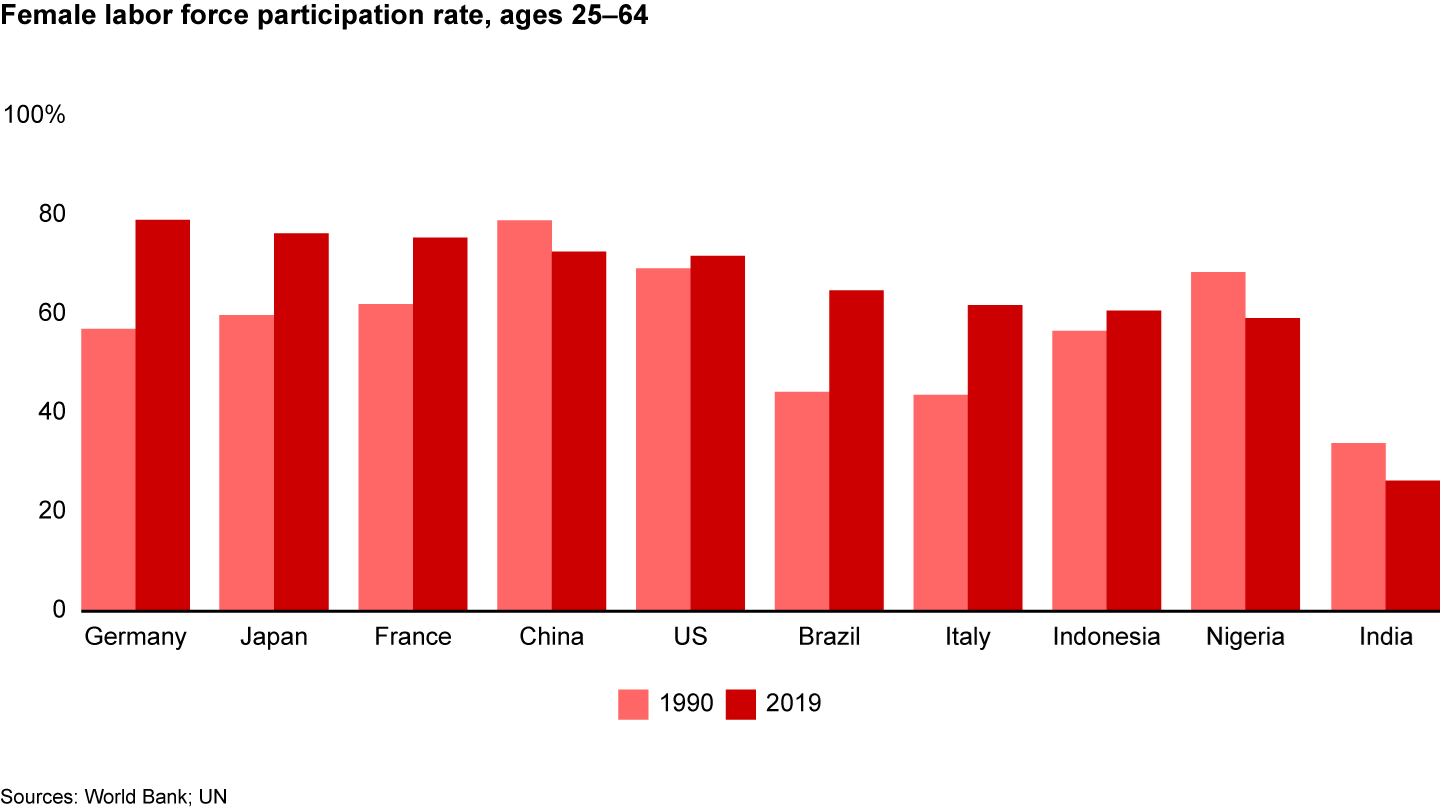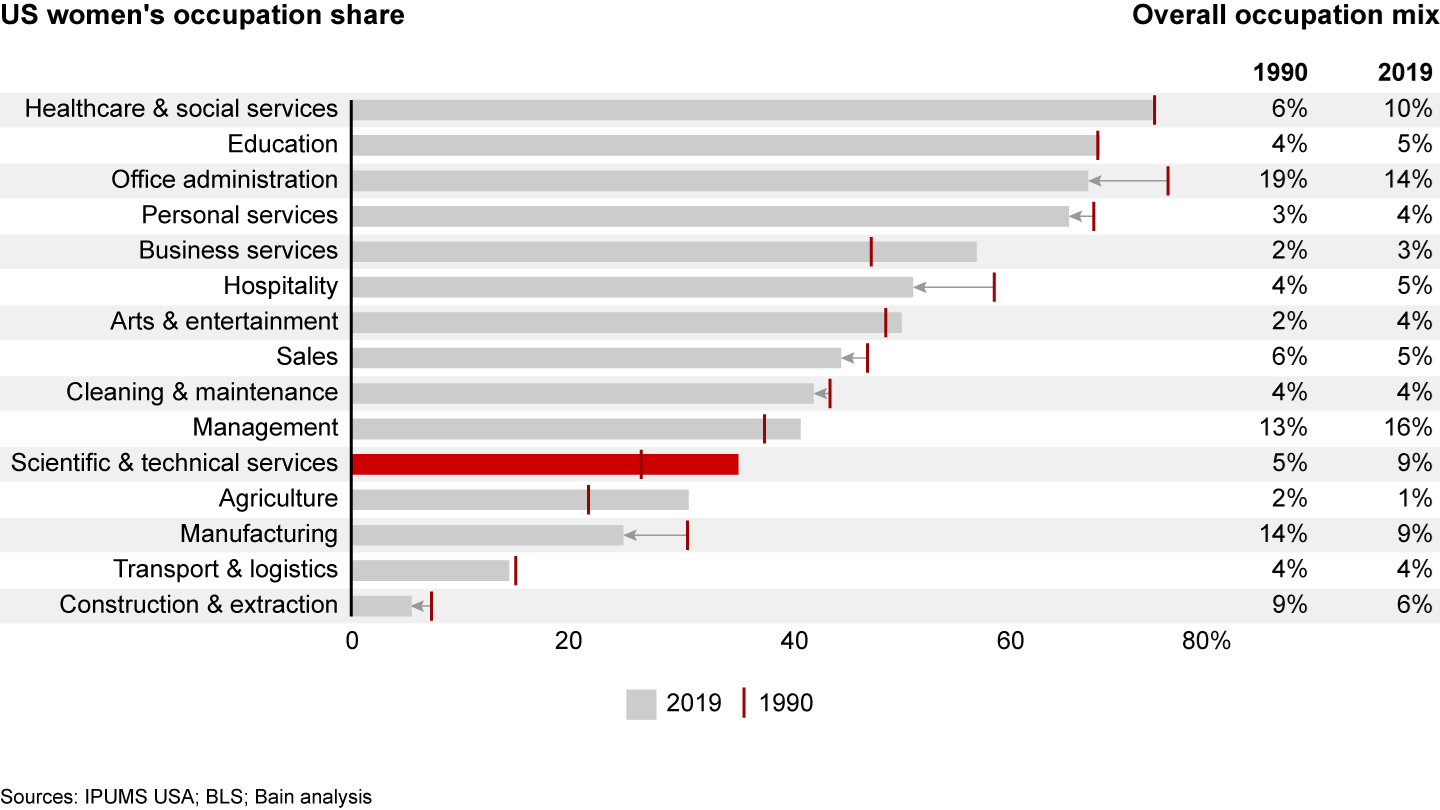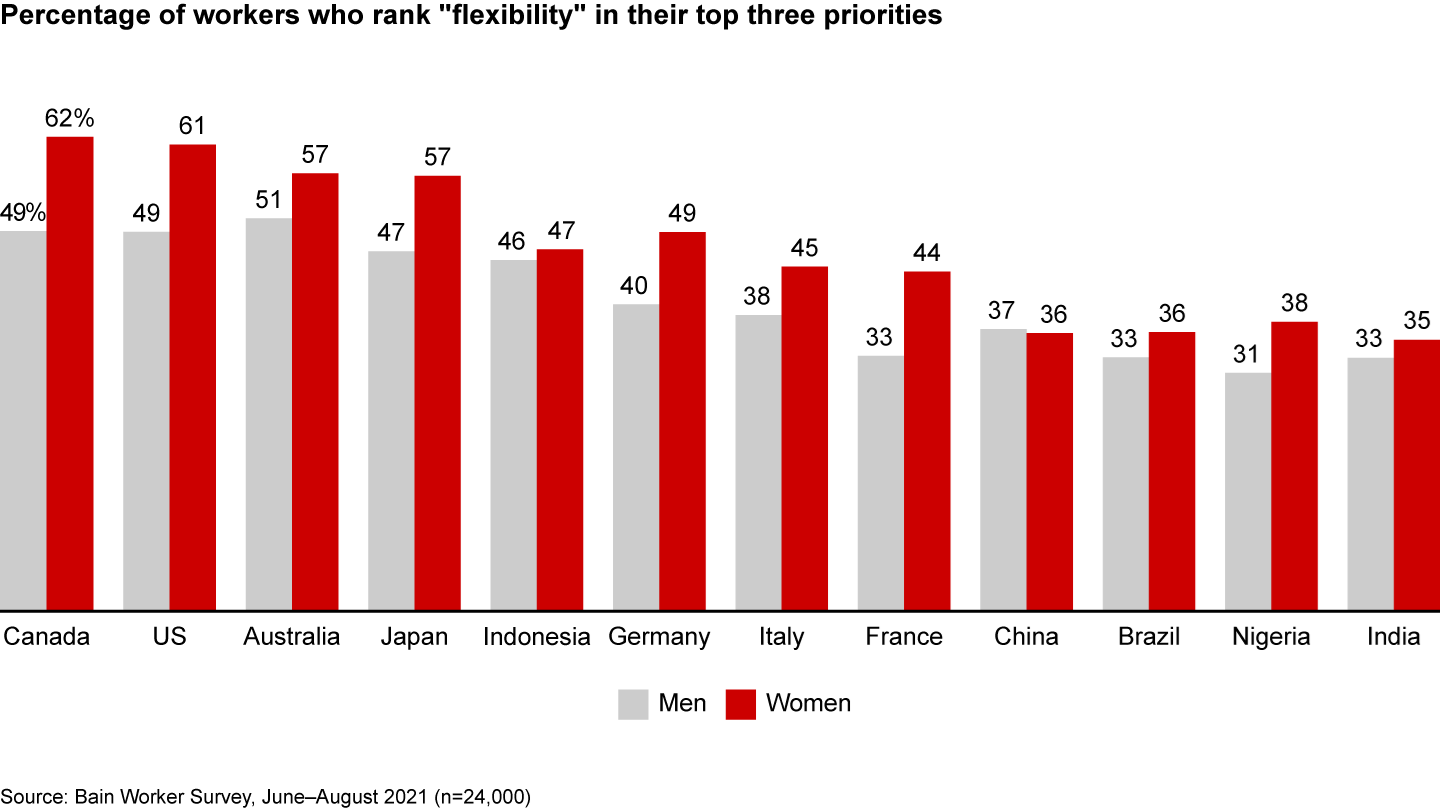Women have spent centuries forging a path in society and the workforce, with much progress: Most countries have extended the right to vote within the last 100 years, and women’s labor force participation has expanded rapidly since the midcentury. But the harsh reality is that women remain scarce in top leadership roles today: They held fewer than 5% of CEO roles globally in 2020.
It’s evident that there’s a long way to go, especially as many places around the world see gender equality reversing. In 2021, women still made up less than 40% of the global workforce, and participation is declining in many faster-growing, lower-income countries, like India and Nigeria (see Figure 1). Covid-19 has also disproportionately affected women’s workforce participation, particularly for non-college-educated women, increasing the gap between men and women.
As companies grapple with current talent shortages, women can be a key part of the solution. Despite different starting points and cultural contexts, every country has an opportunity to bring more women into the workforce, in order to meet talent needs and advance women’s empowerment. Understanding the differences—and similarities—between women and men at work is critical for addressing gender parity and winning the war for talent.
Female labor participation is declining in fast-growing, low-income countries


In our research on worker attitudes and motivations, we actually found that what motivates women and men at work is the same. We identified six worker archetypes based on 10 attitudes, including work-centricity, financial orientation, and camaraderie (see “Six Worker Archetypes for the World Ahead”). The mix of those archetypes is strikingly similar in men and women, even following the same trajectory with age. And in our research on inclusion, we found that men and women feel equally included—and excluded—at work. They speak about inclusion in the same manner. Time after time, we find little intrinsic difference between men and women.
And yet, women and men continue to have different outcomes and experiences in the workplace. We see three meaningful imbalances between men and women at work: in occupation selection, in prioritization of flexibility, and in workplace treatment.
Gender biases continue to govern occupation choice. While occupations have become more balanced in the last 30 years, women remain underrepresented in many higher-paying management and technical occupations (see Figure 2). Women are especially underrepresented in the jobs that are seeing heavy demand today: They hold just 25% of US computing jobs and 13% of engineering jobs.
Why? From an early age, children learn to follow gender expectations in play and career ambitions, based on the idea that girls and boys have different capabilities. In fact, studies have shown that by the age of seven, girls choose more “caring” careers, like teaching and healthcare, and boys choose more stereotypically masculine careers, like engineering. Even though women have closed the college education gap in most countries, graduates of technical fields are mostly men. In the US, the share of women earning bachelor’s degrees in computer science declined from 33% in 1980 to 21% in 2018. The situation is similar globally. Many women cite a prevailing culture of machismo—both in and beyond school—as a deterrent.
Women remain underrepresented in high-demand digital and engineering jobs


At work, women prioritize flexibility more than men (see Figure 3). The deeply rooted expectation that men work and women take care of home duties continues to restrict women (and men). One symptom of this expectation is the disproportionate share of unpaid work by women—160% more in the US and nearly 500% more in Japan. Our research shows that men and women prioritize flexibility equally early in their careers. However, as US workers age, flexibility grows in importance for women and declines for men.
Moving to a flexible role can be a catch-22. Flexible work arrangements, like part-time work, can keep women in the workforce, but at a steep wage and career advancement cost. In fact, part-time work is one of the main contributors to the pay gap. In the US, twice as many women work part time than men (of those, nearly 9 times more women voluntarily work part time due to family needs). The share of women in part-time work is even higher in many European countries. Three-quarters of Dutch women work part time, mostly to balance childcare and work.
What’s more, many women who continue to work full time may steer away from “high-intensity” jobs, as they perceive them to be more unpredictable. Women are also more likely to take extended leaves. More than 30% of women who reduced hours or took an extended leave say it hurt their career, compared with fewer than 20% of men. The difference in rates of flexible work between men and women reflects society’s acceptance of women who move into part-time work or extended leaves, but not men, which can leave both men and women feeling unfulfilled.
Women prioritize flexibility in their careers more than men


Bias continues to perpetuate differential treatment for women. Many workplace behaviors and structures are rooted in conscious and unconscious bias, with systems that were designed with the majority (men) in mind. This leads to differential treatment for women. While women often receive mentorship, or are shown what to do, many lack sponsorship—they are not championed for their contributions, as male leaders at the top are more likely to sponsor men. Systems for promotion can also result in biased outcomes when leaders assess subjective promotion criteria, such as “leadership potential,” in a way that favors men. For example, workplaces often celebrate assertiveness in men but not women (even citing it in favor of promotion), leading to a cultural double standard.
Women are also asked to do (and accept) more administrative work and emotional labor that generally isn’t compensated. This differential treatment can make women’s climb up the ladder more difficult. As a result, the wedge between men’s and women’s ambitions grows by mid-career.
But the traditional climb up the ladder may be overvalued today. Firms of the future can expect fewer people to follow a linear managerial path, and more to take a “passport” approach to their careers—exploring different roles, flexible work, and on- and off-ramps as part of their career journey. This cultural change, paired with actions to increase the number of women in leadership roles, can reset the value systems to be more equitable at all levels of the organization.
Five imperatives for leading firms
Leading firms will proactively address the gender imbalances that hold women back, with senior leaders championing the efforts, to attract and retain top talent. While there are many ways that firms can address gender equity, the following five imperatives begin to tackle the deeply rooted gender imbalances we find in our research. And they have the power to uplift not only women, but all workers.
Be wary of averages
Not all women are the same, of course, and neither are their needs. There is far greater variation among women (or men) than between men and women. While there are some differences in the mix of worker archetypes at the intersection of gender, race, and age, every subgroup includes all six worker archetypes. So, treating women, men, or any group as a single block obscures the varied needs of individual workers. Recognizing that multiple factors make up someone’s lived experience can help firms move beyond averages.
In order to attract and retain the best workers, while also ensuring that the right people are in the right jobs, leading firms are adopting a more tailored approach to worker needs. For some workers, that will mean ensuring that their work is aligned with their passion. For others, that may mean offering flexibility paired with career progression.
Some firms are trialing more tailored approaches for employees. Sodexo, for example, introduced an initiative called FLOW, which allows employees to work with their managers on individual work flexibility plans. Procter & Gamble launched “P&G and Me” to reframe and tailor the employee value proposition to individual workers’ needs and ambitions. The program also encourages open conversations between employees and their managers, with midyear check-ins focused on questions like “Are you inspired?” and “What’s the most meaningful work?”
Multinational firms will also have to tailor inclusion and gender parity initiatives to different markets and localize their strategy. L’Oréal, which operates in 150 countries, has implemented localized diversity initiatives relevant to the countries where team members live and work, such as a refugee training program in Kenya, pregnancy support in India, and a mental health awareness campaign in the UK.
Actively fight traditional gender bias with diverse role modeling and sponsorship
Gender bias can hold workers back from their full potential. Firms can actively challenge bias by elevating diverse role models, ensuring equal access to sponsorship, promoting allyship, and embedding concrete bias mitigation efforts.
Diverse role models play an important role in career aspiration. And seeing leaders who challenge traditional gender norms, such as men who have taken extended leaves for family care, can help mitigate bias. Seeing leaders with similar backgrounds can also improve aspiration and retention, but sponsors need not come from the same background. Our research shows that mentors with different backgrounds or identities than their mentees are equally as effective as mentors with similar backgrounds or identities. Allies are important in amplifying voices as well—particularly those that may not be the loudest or in the majority.
Bias mitigation efforts in recruiting and promotion are also crucial. These can include redacting information from résumés during the review process, ensuring job descriptions are inviting to all, clarifying subjective or ambiguous success criteria, and requiring bias trainings for interviewers, managers, and promotion reviewers.
To address gender bias within the firm, many companies offer gender-neutral paid parental leave. Others compensate employees for mentorship and community-building efforts. At LinkedIn, leaders of employee resource groups, such as Women at LinkedIn or Black Inclusion Group, are compensated for their work advancing inclusion in addition to their regular jobs. And Vodafone piloted a gender-blinded application review process, which led to more women receiving interviews.
To tackle gender bias outside the firm, Unilever launched the “Unstereotype” initiative with the UN. They harnessed the power of advertising to help shape perceptions through realistic, nonbiased portrayals of women and men. And Google’s Women Techmakers program supports current and aspiring women in tech through global ambassadors, who host training and community-building events for the budding female technologists.
Instill inclusive practices as an antidote to gender imbalance
Creating an inclusive work environment boosts team performance and improves worker retention, especially among women. We define inclusion as the feeling of belonging in one’s organization and team, being treated with dignity as an individual, and being encouraged to fully participate and bring one’s authentic self to work every day. Bain research shows that fewer than 30% of women and men feel fully included at work, so there is plenty of opportunity for improvement.
Inclusion is necessary to maximize retention, performance, and innovation. It unlocks the power of a diverse workforce. The benefits of inclusion for women are especially striking: Our survey reveals that women who feel excluded at work are three times more likely to quit than those who feel included. In comparison, men are only twice as likely to quit.
We believe that there are three highly critical steps to boost inclusion for all.
- Promote growth, through instilling stronger rituals around professional development, coaching, and sponsorship. Verizon, for instance, has a tailored “Talent GPS” program that offers visibility into different career pathways and encourages skills-based conversations between employees and their managers.
- Facilitate connection. Some companies are doing this through affinity groups and networks of allies. For example, Johnson & Johnson has invested in employee resource groups, increasing participation eightfold since 2015.
- Signal commitment, with clearly defined and communicated diversity, equity, and inclusion ambitions. Firms like cloud company Box gather employee feedback in an inclusion survey, in order to create an actionable strategy to improve the employee experience.
Leaders who adopt inclusive behaviors, like showing empathy, are especially critical in ensuring women feel included. The daily interactions employees have with supervisors play a large role in building—or eroding—confidence and ambition. This is particularly true for women, although inclusive behaviors help men feel included, too. Like the curb-cut effect, where sidewalk ramps designed for people in wheelchairs ended up benefiting cyclists, parents pushing strollers, and others, firms that focus on inclusive practices will uplift not only women, but all employees.
Champion flexible workers and eliminate barriers to their success
For workers who need or want flexibility, part-time or remote work can keep them in the workforce. But these arrangements often come with career deceleration and steep pay penalties. Our survey shows that part-time workers are less satisfied in their jobs. While more women are in part-time and flexible work arrangements today, men are increasingly prioritizing flexibility, too. More than 60% of US workers don’t want to return to the office full time, according to a Bain survey. In this environment, finding ways to support different work models and mitigate barriers to success is more important than ever.
Part-time and remote workers often experience bias, including in promotion. Remote workers are less likely to be promoted despite similar or greater productivity. Many of the same bias mitigation tactics for gender bias will also help workers who prioritize flexibility. Beyond bias trainings and eliminating ambiguous success criteria, leading companies will create opportunities for remote or flexible workers to have dedicated in-person time with their managers and firm leaders.
The video conferencing company Zoom allows its employees to choose an in-person, remote, or hybrid work model, and the choice doesn’t have to be fixed—employees can switch if the model isn’t working for them. Zoom managers are required to complete bias training to ensure equitable treatment across work models. Airbnb has a single-pay-tier, work-from-anywhere policy. In this remote-first model, quarterly in-person meetings help keep all workers on a level playing field. At our firm, workers across tenure levels can move to part-time (often 60% or 80% time) arrangements while continuing to advance, and models of success are championed.
Celebrating the successes of flexible workers in town hall meetings, annual reports, and awards is critical. Stryker recently launched four models of flexible work (remote, in-field, on-site, and hybrid) and celebrates employees in each model through profiles on its website.
Unlock new talent pools through reskilling and returners programs
Women are more likely than men to off-ramp and take an extended leave mid-career, often due to family obligations. And while roughly 90% of women want to return, only 40% actually do. Nearly three-quarters of women trying to return to work after a voluntary leave have trouble finding a job.
Workers who have taken extended leaves represent a promising talent pool but may need to learn new hard or soft skills to reenter the workforce. Returners programs that offer training for in-demand digital skills can also improve the gender balance in higher-growth occupations. In addition, reskilling or upskilling current workers can improve retention and develop a pipeline of diverse talent into management positions. And former employees can also be an important and often overlooked potential talent pool, especially in a tight labor market.
Avanade, a Dutch IT company, is paying all costs for women to be retrained in IT. Participants receive a job guarantee as soon as they start the program. Avanade has said that it is targeting women to improve workforce diversity and alleviate the pressures of a tight labor market. Reskilling and returners programs need not be targeted specifically at women—Mastercard and Amazon both offer 12- to 16-week returners programs designed for any person who has been out of the workforce for an extended period.
Finding balance
Addressing gender bias is a multiyear journey without a finite destination. But it is critical for ensuring that women at work reach their full potential. In the race for talent, companies cannot afford to leave half their potential talent behind.
The authors would like to thank the following team members for their contributions: Cassy Reichert, Thomas Devlin, Krystle Jiang, Julie Coffman, James Root, James Allen, Karen Harris, Eva Gupta, Neelima Jain, Shreyas Raj Krishna, Nitya Pahuja, and the Bain Futures team at the Bain Capability Network.